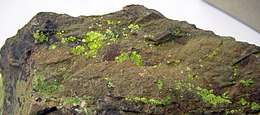Tangeite
| Tangeite | |
|---|---|
 | |
| General | |
| Category | Phosphate mineral |
| Formula (repeating unit) | CaCu(VO4)(OH) |
| Strunz classification | 8.BH.35 |
| Dana classification | 41.05.01.06 |
| Crystal system | Orthorhombic |
| Crystal class |
Disphenoidal (222) H-M symbol: (2 2 2) |
| Space group | P212121 |
| Unit cell |
a = 7.45 Å, b = 9.26 Å c = 5.91 Å; Z = 4 |
| Identification | |
| Color | Yellow, yellow-green, olive green, green to dark green |
| Crystal habit | Rarely as short prismatic crystals, commonly as fibrous to botryoidal encrustations |
| Cleavage | Perfect on {010}, good on {001} |
| Tenacity | Brittle |
| Mohs scale hardness | 3.5 |
| Luster | Vitreous, pearly on cleavage faces |
| Streak | Light yellow green |
| Diaphaneity | Transparent, Translucent |
| Specific gravity | 3.75 - 3.84 |
| Optical properties | Biaxial (-) |
| Refractive index | nα = 2.010 nβ = 2.050 nγ = 2.090 |
| Birefringence | 0.08 |
| 2V angle | 83° (measured) |
| References | [1][2][3] |
Tangeite, also known as calciovolborthite, is a calcium, copper vanadate mineral with formula: CaCu(VO4)(OH). It occurs as a secondary mineral that can be found in sandstone and also in the oxidized zones of vanadium bearing deposits.
It was named in 1925 by Aleksandr Evgenievich Fersman for its discovery locality in the Tange Gorge, Ferghana Valley, Alai Mountains, Kyrgyzstan.[1]
References
This article is issued from
Wikipedia.
The text is licensed under Creative Commons - Attribution - Sharealike.
Additional terms may apply for the media files.